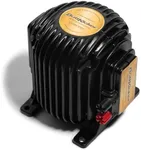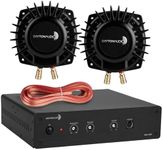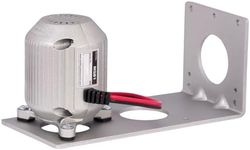Buying Guide for the Best Bass Shaker
Choosing the right bass shaker can significantly enhance your audio experience, whether you're setting up a home theater, gaming setup, or a music studio. Bass shakers, also known as tactile transducers, are devices that convert audio signals into vibrations, allowing you to feel the bass rather than just hear it. This can add a new dimension to your entertainment, making it more immersive and engaging. When selecting a bass shaker, it's important to consider several key specifications to ensure you get the best fit for your needs.Power HandlingPower handling refers to the amount of power (measured in watts) that the bass shaker can handle without being damaged. This is important because it determines how much vibration the shaker can produce. Generally, higher power handling means stronger and more intense vibrations. If you are looking for subtle vibrations, a lower power handling shaker might be sufficient. For more intense and immersive experiences, especially in larger setups, opt for a shaker with higher power handling.
Frequency ResponseFrequency response indicates the range of frequencies the bass shaker can reproduce. This is crucial because it affects the quality and depth of the vibrations. A wider frequency response means the shaker can handle a broader range of sounds, from deep bass to higher tones. If you want to feel the full spectrum of audio, choose a shaker with a wide frequency response. For those primarily interested in deep bass, a shaker with a narrower, low-end focused frequency response might be more suitable.
Mounting OptionsMounting options refer to the different ways you can install the bass shaker. This is important for ensuring the shaker can be securely attached to your furniture, seating, or other surfaces. Common mounting options include screw mounts, adhesive mounts, and clamp mounts. Consider where you plan to install the shaker and choose a mounting option that is compatible with that surface. For example, screw mounts are ideal for permanent installations, while adhesive mounts might be better for temporary setups.
ImpedanceImpedance, measured in ohms, is the resistance the bass shaker offers to the electrical current. This is important because it affects how the shaker interacts with your amplifier or receiver. Most bass shakers have an impedance of 4 or 8 ohms. Ensure that the impedance of the shaker matches the output impedance of your amplifier to avoid any compatibility issues. If you are unsure, consult your amplifier's specifications or seek advice from a professional.
Size and WeightSize and weight are important considerations for the physical installation and overall integration of the bass shaker into your setup. Larger and heavier shakers typically produce stronger vibrations but may require more robust mounting solutions. Smaller and lighter shakers are easier to install and may be more suitable for compact setups. Consider the space you have available and the type of furniture or surface you will be mounting the shaker on when choosing the size and weight.













